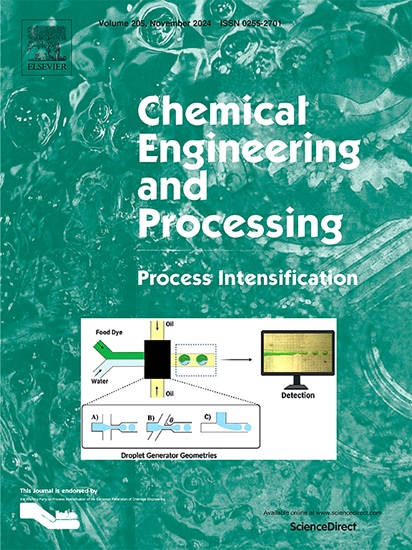基于配方的nh3合成-吸附一体化反应器的一维动力学建模
IF 3.9
3区 工程技术
Q3 ENERGY & FUELS
Chemical Engineering and Processing - Process Intensification
Pub Date : 2025-07-07
DOI:10.1016/j.cep.2025.110387
引用次数: 0
摘要
通过灵活高效的氨(NH3)合成,可以实现长期绿色储氢。通过吸附剂集成的过程强化,理想的无循环NH3合成装置可以在NH3合成过程中实现更温和的压力和温度水平,同时将单道转换转移到热力学平衡之外。理解这种新型集成合成-吸附反应器(SSR)的过程行为需要基于吸附和反应现象的化学平衡和动力学分析和选择合适的催化和吸附材料。本研究首先提出了平衡热力学分析,以提供所需SSR的初步性能评估,评估了几种候选吸附材料。在此基础上,建立了一个新的压力驱动的动态模型,以严格评估固定床SSR在预定操作配方下分批循环操作的固有瞬态动力学。通过一致的守恒方程来描述流动、反应和吸附现象的相互作用,推导出一个物理上精确的模型。根据操作配方,模拟结果显示NH3产率为60.9%,大大超过了最先进的Haber-Bosch反应器通常达到的10-15%的单道转化率。此外,敏感性分析表明,为了减轻脱附过程中催化剂材料存在的反反应影响,材料开发的主要焦点应该是吸附剂动力学,而不是催化剂动力学。虽然需要进一步的材料开发,但该研究首次对氨合成的集成SSR进行了严格的动态评估。本文章由计算机程序翻译,如有差异,请以英文原文为准。

Recipe-based 1-D dynamic modeling of an integrated NH3-synthesis-sorption reactor
Long-term green hydrogen storage can be realized via flexible and efficient ammonia (NH3) synthesis. Process intensification via a sorbent-integrated, ideally recycle-less NH3-synthesis unit enables milder pressure and temperature levels during NH synthesis, while shifting the single-pass conversion beyond the thermodynamic equilibrium. Understanding the process behavior of this novel, integrated synthesis-sorption reactor (SSR) requires an analysis and choice of suitable materials for catalysis and sorption based on the chemical equilibrium and kinetics of both the sorption and reaction phenomena. This study first proposes an equilibrium thermodynamic analysis to provide an initial performance assessment of a desired SSR, evaluating several sorbent material candidates. On this basis, a novel, pressure-driven dynamic model is developed to rigorously assess the inherently transient dynamics of a fixed-bed SSR in cyclic batch-wise operation under a predefined operation recipe. By consistent formulation of the conservation equations to describe the interplay of flow, reaction, and sorption phenomena, a physically accurate model is derived. Given the operation recipe, the simulation results highlight an NH yield of 60.9%, substantially exceeding the single-pass conversion of 10-%, typically achieved in state-of-the-art Haber–Bosch reactors. Additionally, a sensitivity analysis reveals that sorbent kinetics, rather than catalyst kinetics, should be the primary focus of material development to mitigate the effects of back-reaction in the presence of catalyst material during desorption. While the need for further material development is highlighted, this study provides the first rigorous dynamic evaluation of an integrated SSR for ammonia synthesis.
求助全文
通过发布文献求助,成功后即可免费获取论文全文。
去求助
来源期刊
CiteScore
7.80
自引率
9.30%
发文量
408
审稿时长
49 days
期刊介绍:
Chemical Engineering and Processing: Process Intensification is intended for practicing researchers in industry and academia, working in the field of Process Engineering and related to the subject of Process Intensification.Articles published in the Journal demonstrate how novel discoveries, developments and theories in the field of Process Engineering and in particular Process Intensification may be used for analysis and design of innovative equipment and processing methods with substantially improved sustainability, efficiency and environmental performance.

 求助内容:
求助内容: 应助结果提醒方式:
应助结果提醒方式:


